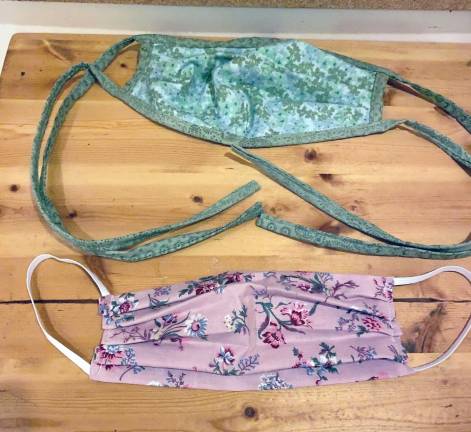The joy of giving and receiving inspires the Milford Mask Group
Milford. Volunteers and donations are welcome. Dan MacLeod, a member of the group and a public health care professional, says he's intrigued by studies on the effectiveness of wearing homemade masks: "It seems to me that a homemade mask is better than 'better than nothing.'"

It was clear that the Milford Police and other first responders needed masks.
Mayor Sean Strub, one of the administrators of the Milford Covid 19 Volunteer Task Force, was getting requests for masks and offers to make them. And so the Milford Mask Group was born.
Xavier Morales, who modestly refers to himself as just one of the managers, is the driving force behind the group. He says, though, that Strub was the instigator.
Others in the group are Peggy Owens, Dan MacLeod, Bert MacLeod, Karen Bastidas, and Danielle Schatteman. They generally divide the work by tasks.
For example, Owen troubleshoots requests and generally coordinates communication between members and requestors. Dan and Bert MacLeod pick up materials from different sources. Bastidas does tech. The group stays informed by meeting daily on Zoom.
The Milford Mask Group now has 26 members sewing masks. They've given masks to various senior groups in Milford, including Belle Reeve Senior Living, Twin Cedars Senior Living in Shohola, and the Milford Health Care and Rehabilitation Center.
The group has given out 115 masks to date. About 150 or 200 more are in the pipeline at this moment.
But do they help?
There has been some controversy about the usefulness of homemade masks, but the general feeling is that it’s better than nothing.
Dan MacLeod is a public health care professional who reads just about every study on COVID-19.
“I had been intrigued when I read the studies on the effectiveness of wearing homemade masks," he said. "It seems to me that a homemade mask is better than 'better than nothing.'"
There is also the compelling argument that the limited supply of commercially made masks need to saved for doctors, hospitals, and first responders. Additionally, if people wear the more available homemade masks, they will tend not to touch their face as much and therefore help prevent the spread of the virus..
Senator Pat Toomey says on his twitter account, “Each of us needs to do what we can to stop the spread. One thing we can all do is wear homemade masks in public. My mask could help you. Your mask could help me.”
How-to's
Deaconess Hospital provides instructions on how to make masks at deaconess.com/How-to-make-a-Face-Mask. On that page you can volunteer to make masks or ask for them.
The Atlantic Hospital System adapted this information for their website at atlantichealth.org/patients-visitors/donate-volunteer/donate-supplies-covid-19/make-facemask-help-covid-19.html.
The sewers in the Milford Mask Group use different patterns (all basically following the Deaconess model) depending on the availability of materials. Some have elastic, some have material made ties around the back, others have loops, and still others have Velcro.
Donations of material are appreciated, and donations of elastic are urgently needed. The elastic can be 1/4 or 1/2-inch wide for behind-the-ear masks, or one inch for around-the-head masks. Donations should also have the name of the donor so the group can thank them.
When asked what was the most heartfelt experience of their participation in this group, Peggy Owens said, “It’s the fact that people want to do whatever they can to help as well as the gratefulness of those who receive the masks.”
“It’s how the community has stepped up, and how everyone is so grateful,” said Morales.
The group plans to reach out to postal workers, who don’t have masks, and restaurant workers, as well as others in the community who would like to have these masks.
If you can contribute materials or join the sewers or management group, email milfordmaskgroup@gmail.com.
“It’s how the community has stepped up, and how everyone is so grateful." --Xavier Morales